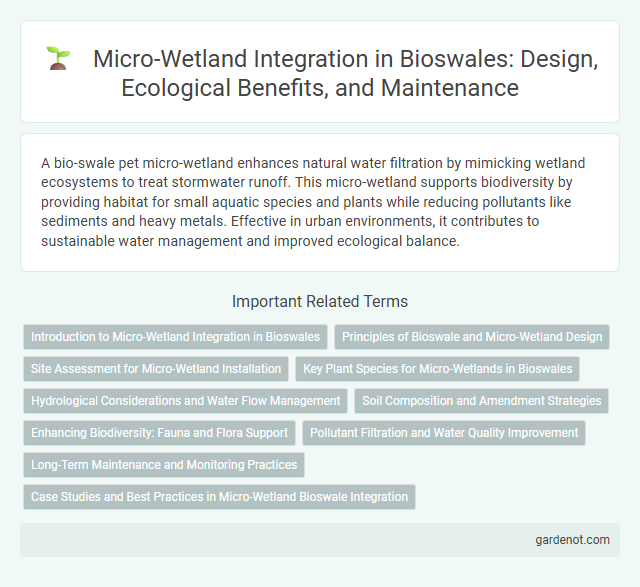A bio-swale pet micro-wetland enhances natural water filtration by mimicking wetland ecosystems to treat stormwater runoff. This micro-wetland supports biodiversity by providing habitat for small aquatic species and plants while reducing pollutants like sediments and heavy metals. Effective in urban environments, it contributes to sustainable water management and improved ecological balance.
Introduction to Micro-Wetland Integration in Bioswales
Micro-wetlands enhance bioswales by incorporating shallow, vegetated basins that improve stormwater management through natural filtration and habitat creation. These systems promote pollutant removal by leveraging microbial activity and plant uptake in saturated soils, leading to increased water quality and biodiversity. Integrating micro-wetlands in bioswales supports sustainable urban drainage while providing ecological benefits in compact green infrastructure designs.
Principles of Bioswale and Micro-Wetland Design
Bioswales and micro-wetlands function by directing stormwater through engineered landscapes that promote filtration, sedimentation, and biofiltration, removing pollutants naturally before water infiltrates the soil or is discharged. Key design principles include grading for optimal flow velocity, selecting native vegetation that enhances pollutant uptake and provides habitat, and incorporating layers of engineered soils and substrates to maximize contaminant removal. Proper sizing based on watershed area and rainfall intensity ensures effective retention and treatment, supporting sustainable urban water management and ecosystem resilience.
Site Assessment for Micro-Wetland Installation
Site assessment for micro-wetland installation involves analyzing soil permeability, hydrology, and existing vegetation to ensure optimal water filtration and habitat support. Evaluating watershed characteristics and pollutant load aids in determining the micro-wetland's capacity to improve water quality effectively. Accurate site selection based on topography and drainage patterns maximizes the bio-swale's efficiency in mitigating runoff and controlling erosion.
Key Plant Species for Micro-Wetlands in Bioswales
Key plant species for micro-wetlands in bioswales include native sedges (Carex spp.), rushes (Juncus spp.), and wetland grasses such as Panicum virgatum, which enhance pollutant filtration and support biodiversity. These hydrophytic plants have extensive root systems that improve soil permeability and facilitate nutrient uptake, crucial for maintaining water quality. The strategic selection of these species optimizes bioswale performance in stormwater management and habitat creation.
Hydrological Considerations and Water Flow Management
Micro-wetlands within bio-swales play a crucial role in hydrological considerations by enhancing water flow management through natural filtration and sedimentation processes. These systems slow stormwater runoff, allowing increased infiltration and reducing peak discharge rates to downstream waterways. Effective design integrates micro-wetlands to optimize pollutant removal while maintaining balanced hydrodynamics for sustainable urban water management.
Soil Composition and Amendment Strategies
Micro-wetlands in bio-swales rely heavily on engineered soil blends composed of sandy loam, organic compost, and biochar to optimize water retention and pollutant filtration. Amendment strategies focus on increasing microbial activity and nutrient cycling by incorporating locally sourced amendments such as composted green waste and mycorrhizal fungi. This tailored soil composition enhances denitrification and heavy metal adsorption, crucial for effective stormwater treatment in micro-wetland systems.
Enhancing Biodiversity: Fauna and Flora Support
Micro-wetlands within bio-swales create critical habitats that significantly boost local biodiversity by supporting a variety of aquatic and terrestrial fauna such as amphibians, insects, and birds, as well as diverse native plant species. These ecosystems improve water quality through natural filtration, promoting healthier habitats that sustain complex food webs and encourage species richness. The integration of micro-wetlands in bio-swale design enhances ecological resilience and fosters sustainable urban biodiversity conservation.
Pollutant Filtration and Water Quality Improvement
Micro-wetlands within bio-swales play a crucial role in pollutant filtration by trapping sediments, nutrients, and heavy metals through natural vegetation and microbial activity. These micro-wetlands enhance water quality by promoting sedimentation and facilitating biochemical processes that break down contaminants. Effective integration of micro-wetlands in bio-swale design significantly reduces runoff pollution and supports sustainable urban water management.
Long-Term Maintenance and Monitoring Practices
Micro-wetlands within bio-swales require consistent long-term maintenance and monitoring to ensure optimal pollutant removal and hydraulic performance. Routine inspections should track vegetation health, sediment accumulation, and inlet/outlet functionality, with adaptive management addressing invasive species and sediment buildup. Data-driven assessments over multiple years help refine maintenance intervals and improve ecosystem resilience.
Case Studies and Best Practices in Micro-Wetland Bioswale Integration
Micro-wetlands integrated within bioswales demonstrate enhanced stormwater filtration and biodiversity support, as evidenced by the success of Portland's Tryon Creek Bioswale and Singapore's Bishan-Ang Mo Kio Park. Case studies highlight optimized sediment retention, nutrient removal efficiencies exceeding 70%, and native plant species selection as key best practices. These projects showcase scalable designs that improve urban water quality while promoting habitat connectivity in dense metropolitan environments.
Micro-wetland Infographic

 gardenot.com
gardenot.com